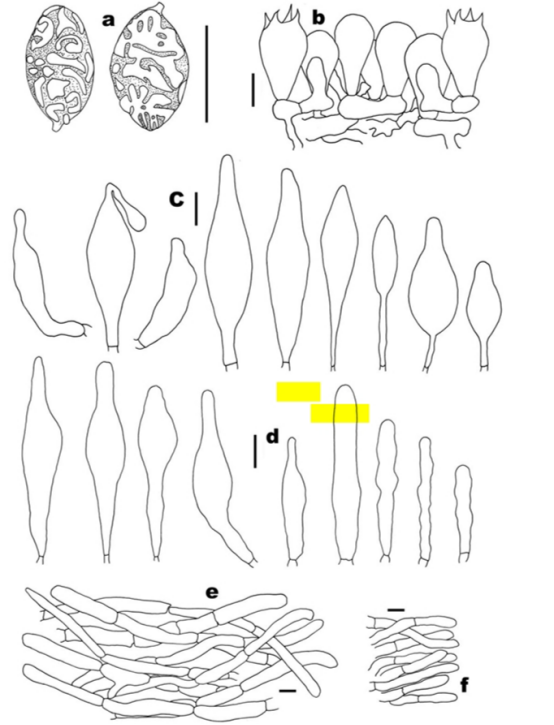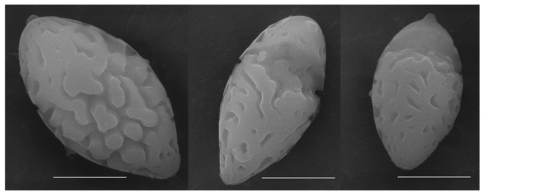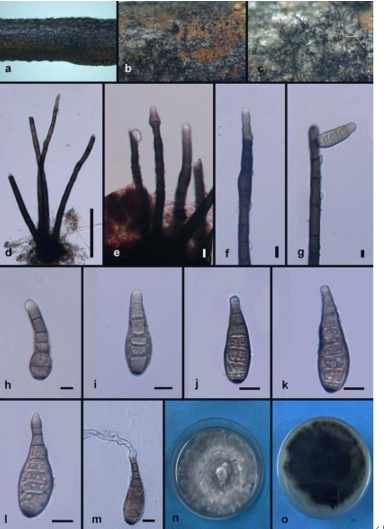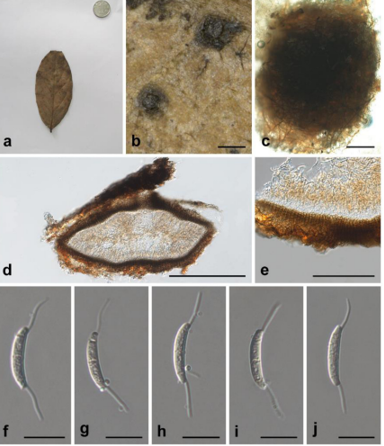Austroboletus brunneisquamus.2021
Austroboletus brunneisquamus N.K. Zeng, Chang Xu and S. Jiang, sp. nov.2021
Mycobank: MB838577
Holotype: CHINA. Hainan Province: Ledong County, Yinggeling of Hainan Trop ical Rainforest National Park, 1091717 E, 18516 N, elev. 650 m, 2 July 2020, N.K. Zeng4294 (FHMU5876).
Morphological Description:
Sexcual morph:Basidiomata: small to medium-sized. Pileus: 3–6.5 cm in diam, sub hemispherical when young, then convex to applanate; margin: decurved; surface: dry, discovered in Japan, has a smaller pileus with a viscid surface, large basidiospores measuring 13.5–18.5 × 8–11 μm with subcylindrical or namentation, and a trichodermium pileipellis [1,43]; A. subflavidus has longer basidio spores measuring 13.1–19.5 × 5.5–8.7 μm with Qm = 2.26, a pileipellis in the form of a trichoderm, and a distribution in North America–Central America–northern South Amer ica [5]. Molecular evidence provided in this study also indicated that A. brunneisquamus is genetically distant from A. dictyotus and A. fusisporus, respectively, and it is somewhat related to A. subflavidus, as these two taxa belong to the same clade (not species level) (Figure 1). subtomentose when young, which cracks into areolae, with large, pale brown (3C7–8) and brown to dark brown (5E7–8) scales; context: 0.5–1.2 cm thick in the center of the pileus, white (1A1), unchanging in color when injured. Hymenophore: poroid, depressed around the stipe; pores: subrounded, white (1A1) when young, then pink (8A2), unchanging in color when injured; tubes: 0.6–1.5cm in length, pinkish (9A2), unchanging in color when injured. Stipe: 4.5–9 0.7–1.4 cm, central, subcylindrical, solid; surface: distinctly covered with a yellowish brown (4B5–6) reticulation; context: white (1A1), unchanging in color when injured; basal mycelium: white (1A1). Odor: indistinct. Basidiospores: [60/3/3] (11–)12–14.5(–15) 6–8(–8.5) m, Q = (1.57–)1.60–2.00 (–2.17), Qm=1.80 0.14(including ornamentation), [60/3/3] (9–)11–13.5(–14.5) 4–6 (–6.5) m, Q=(1.8–)1.92–2.78 (–3.25), Qm = 2.37 0.29 (excluding ornamentation), fusiform or amyg daliform, with a fine cristate to subreticulate ornamentation, pale yellowish brown in KOH. Basidia: 18–26 11–15 m, broadly clavate, thin to slightly thick-walled (up to 0.7 m), 4-spored, colorless in KOH; sterigmata: 4–6 m long. Cheilocystidia: 27–54 7–14 m, Pleurocystidia: 27–62 Author Contributions: Conceptualization, Z.-Q.L. and N.-K.Z.; Methodology, C.X. and M.-S.S.; Per forming the experiment, C.X.; Formal analysis, C.X. and Z.-Q.L.; Resources, N.-K.Z., S.J., Y.C., and Y.-G.F.; Writing—original draft preparation, C.X.; Writing—review and editing, Z.-Q.L. and N. K.Z.; Supervision, N.-K.Z.; Project administration, N.-K.Z.; Funding acquisition, N.-K.Z. All authors have read and agreed to the published version of the manuscript. abundant, fusiform or subfusiform, slightly thick-walled (up to 0.9 m), colorless in KOH. 4–12 m,mostly fusiform, occasionally subclavate or subcylindrical, slightly thick-walled (up to 0.9 m), colorless in KOH. Pileipellis: a cutis up to 315 m thick, composed of cylindrical hyphae 6.5–13 m wide, occasionally branched, slightly thick-walled (up to 0.9 m), colorless in KOH; terminal cells: 44–64 6–10.5 m, sub Funding: This study was supported by the Hainan Provincial Natural Science Foundation of China (no. 820RC633), and the National Natural Science Foundation of China (nos. 31760008 and 31560005). Data Availability Statement: The sequence data generated in this study are deposited in NCBI Gen Bank. cylindrical, with obtuse apex. Pileal trama: made up of hyphae 4–12 m in diam, slightly thick-walled (up to 0.9 m), colorless in KOH. Stipitipellis: a trichoderm-like structure, 70–105 mthick,composedofslightlythick-walled (up to 0.9 m)hyphae, 5.5–7.5 mwide, colorless in KOH; terminal cells: 24.5–53 6–6.5 m, clavate, subclavate or subcylindrical. Acknowledgments: The first author is very grateful to Hui-Jing Xie, Xu Zhang, and Yu-Zhuo Zhang, Hainan Medical University, for their help with molecular data analyses, and the forest rangers, Yinggeling Branch of Hainan Tropical Rainforest National Park, China, for their kind help during the field investigations. Stipe trama: composed of parallel hyphae, 4–15 m wide, cylindrical, slightly thick-walled (up to 0.9 m), colorless in KOH. Clamp connections: absent in all tissues
Asexual morph: Undetermined
Culture:Undetermined
Habitat: solitary on the ground in tropical rainforests dominated by fagaceous trees.
Distribution: Southern China (Hainan Province).
GenBank accession numbers: 28S = MW506829, ITS = MZ855495, TEF1 =MW512637.
Notes:
Reference: Xu, C. , Liang, Z. Q. , Su, M. S. , & Zeng, N. K. . (2021). Austroboletus brunneisquamus (boletaceae, boletales), a new ectomycorrhizal fungus from a tropical rainforest, china.

Basidiomata of Austroboletus brunneisquamus ((a) from FHMU5875; (b,c) from FHMU5876, holotype). Photos by Y.G. Fan.

Microscopic features of Austroboletus brunneisquamus (FHMU5876, holotype). (a) Ba sidiospores. (b) Basidia. (c) Cheilocystidia. (d) Pleurocystidia. (e) Pileipellis. (f) Stipitipellis. Figure 3. Microscopic features of Austroboletus brunneisquamus (FHMU5876, holotype). (a) Basidio spores. (b) Basidia. (c) Cheilocystidia. (d) Pleurocystidia. (e) Pileipellis. (f) Stipitipellis. Bars = 10 μm. Drawings by C. Xu. Bars = 10 m.DrawingsbyC.Xu

SEM of basidiospores from a dried specimen of Austroboletus brunneisquamus (FHMU5876, holotype). Bars = 5 m.









